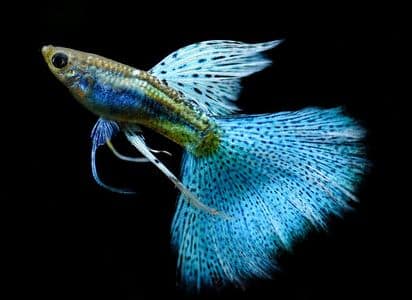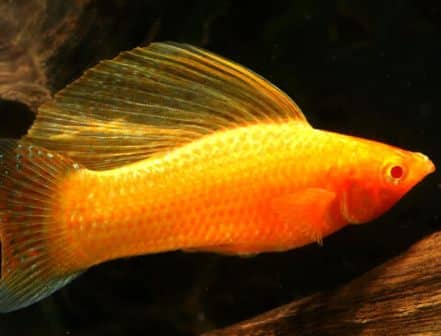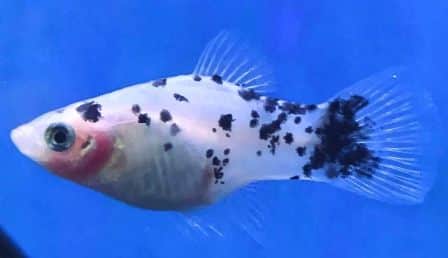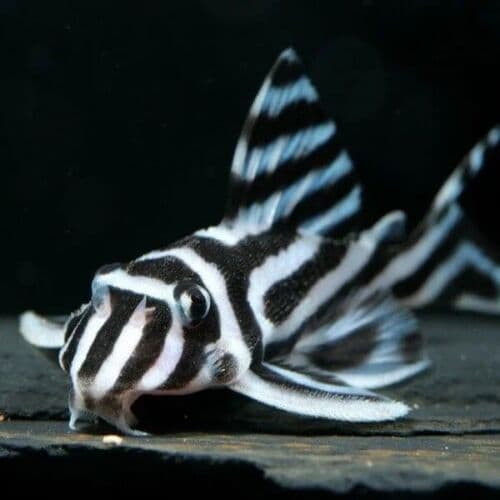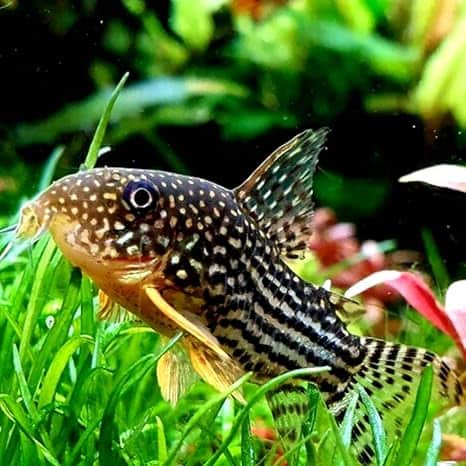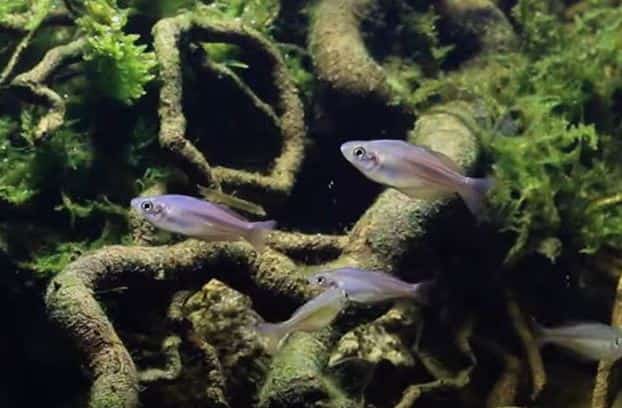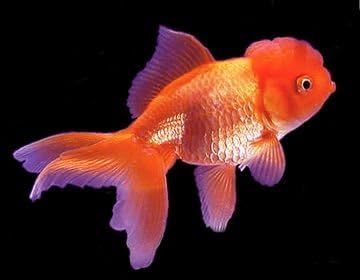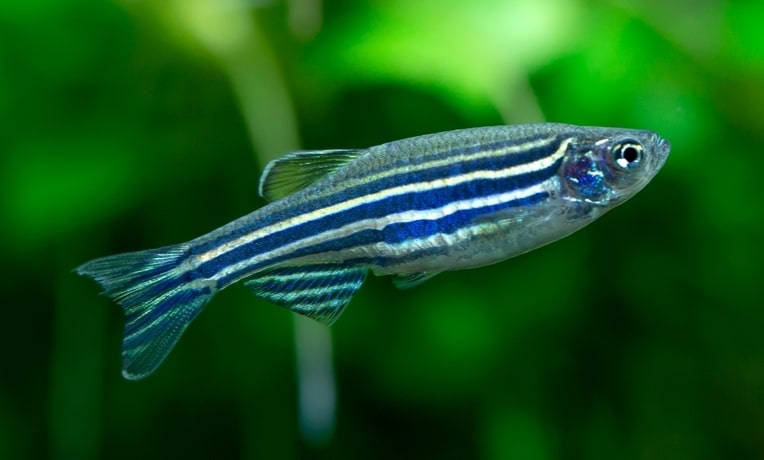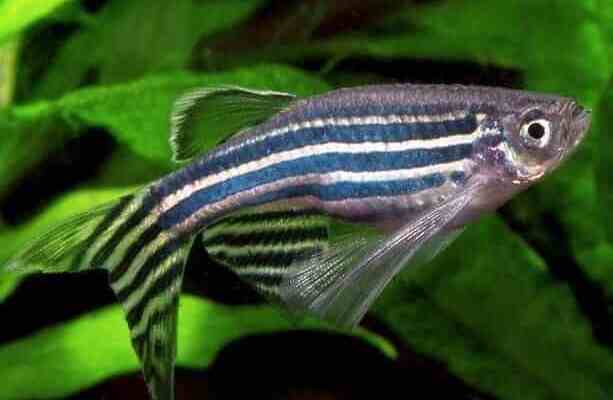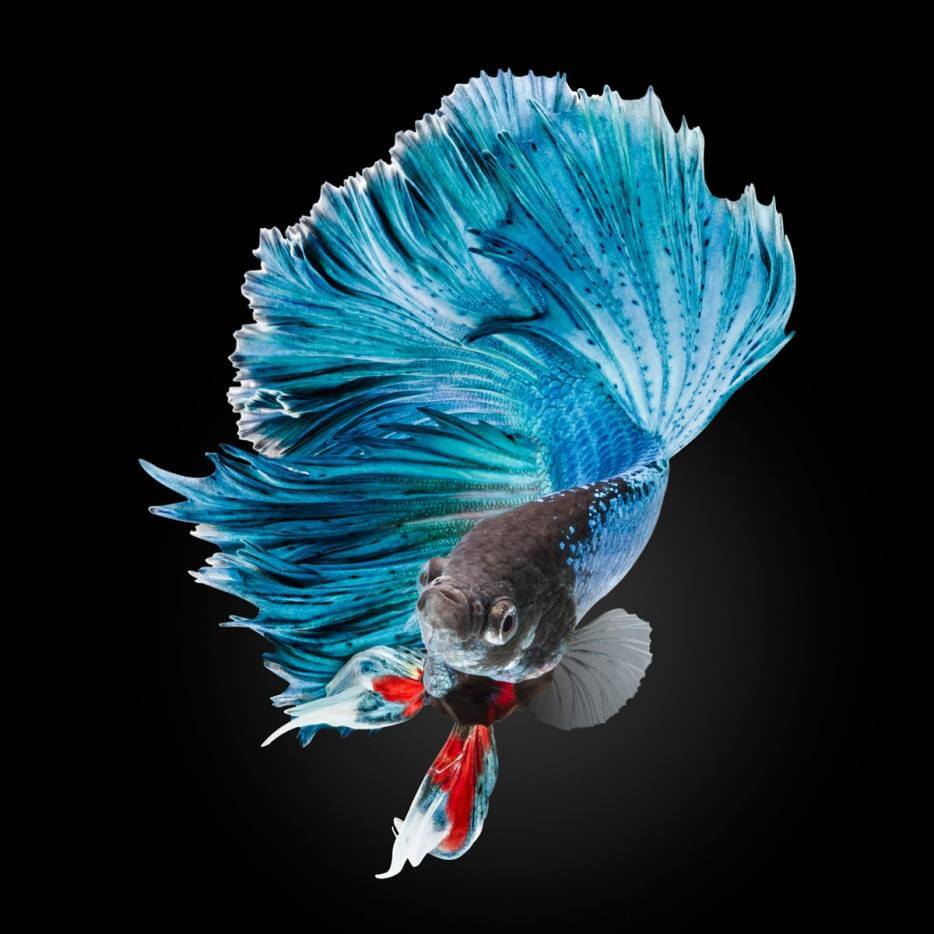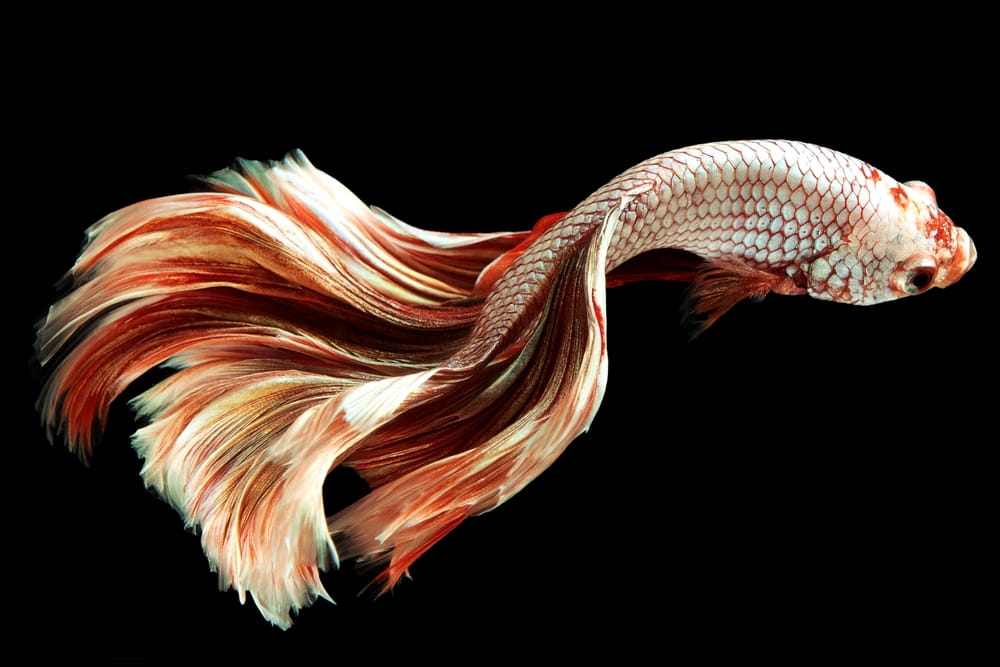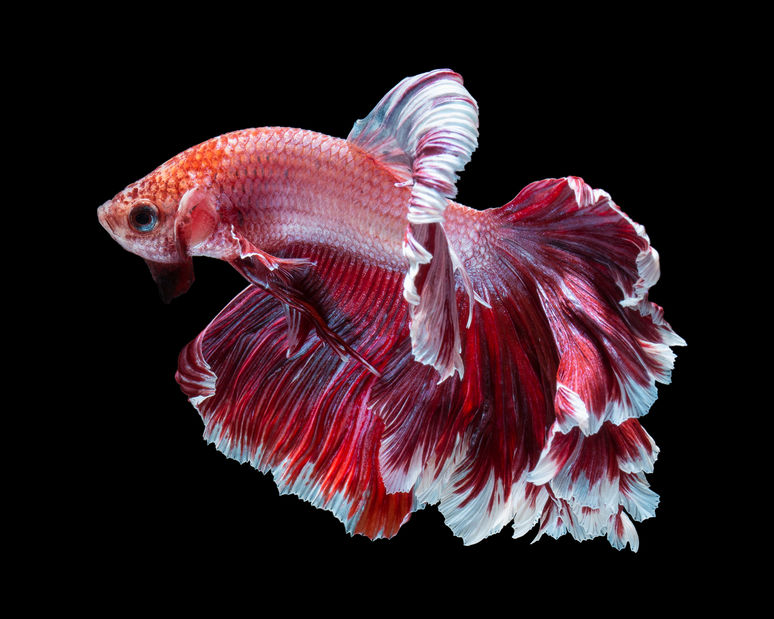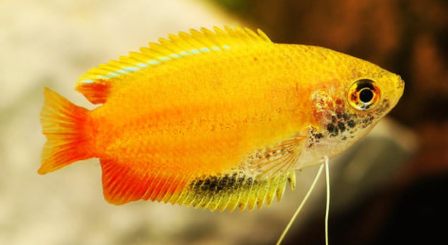The 20 Best Starter Aquarium Fish For Beginners (With Pictures)
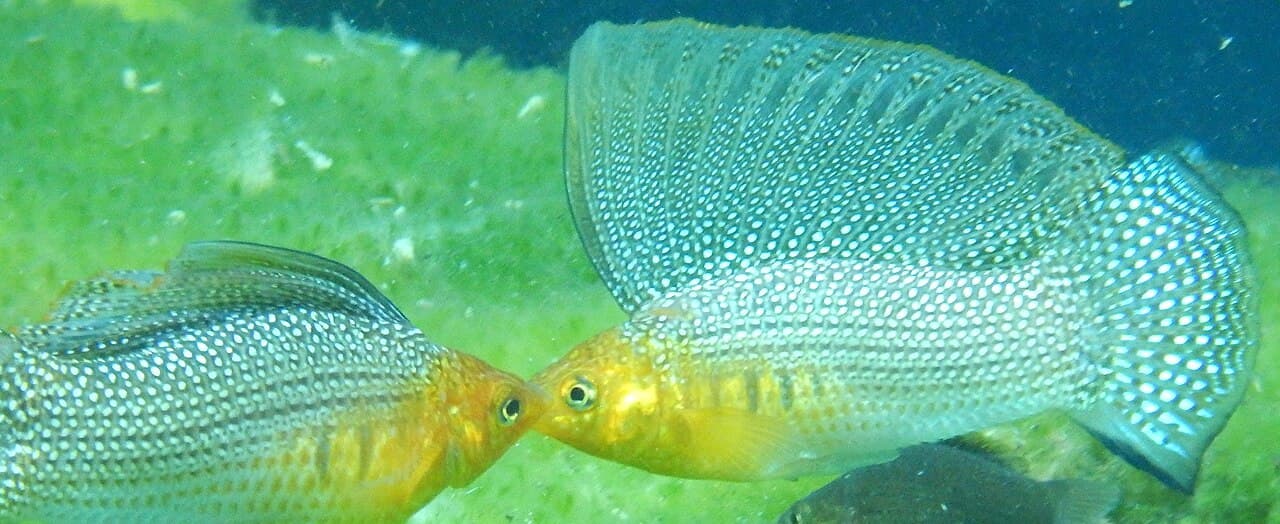
Aquarium Fish For Beginners:
Are you a beginner aquarist? Are you going to start an aquarium? If yes, and if this is your first-ever aquarium, then you’re probably wondering what fish to buy. In this article, I will explore a list of the 20 best starter aquarium fish for beginners. Fish that you will love and that are easy to care for. So, let’s start and explore some beautiful fish for the beginner.
Here is the easiest way to use this page:
1. Scroll through the table of contents to see all the available fish.
2. Use the table of contents links to go directly to the fish you are interested in.
3. You can return here quickly by tapping the white arrow in the small gray box on the far right side of this page.
The amazing Sailfin Molly Fish image at the top of this page is courtesy of Wikipedia and Christine Loew, some rights reserved (CC BY), uploaded by Christine Loew
Guppies
Poecilia reticulata
Ease of care: very easy to keep
Everything You Need to Know About Guppies: 12 Key Facts
Description:
Common name: Guppy (scientific name: Poecilia reticulata) Guppies could easily be the most popular freshwater aquarium fish. They are also known as rainbow fish or million fish.
Size:
A typical male guppy will grow to about one to one and a half inches. Highly bred male guppies will grow somewhat larger. The female will grow to two+ inches.
Male / females:
Male guppies have slim bodies and often have large tails. Female guppies will have a fatter body than the male and is larger than the male.
Lifespan:
Well cared for guppies might live up to 2 years.
Behavior:
Guppies are peaceful and gentle. They get along well with just about any fish similar in size to themselves.
Colors:
There are a lot of color variations in guppies, including red, blue, yellow, white, orange, black, and “metal” colors (see the metal-colored guppy pictured above).Wild guppies typically exhibit a plain tan color with a few black dots. Selective breeding has resulted in dramatic colors and large tail fins in domestically kept guppies. Male guppies with tail fins larger than their bodies are now common.
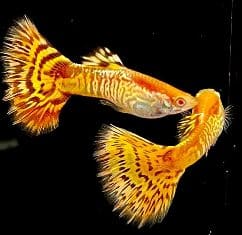
Water conditions:
Guppies are not too particular about water conditions. Keep at tropical fish temps of around 78 degrees F.
Cost:
$2 or $3 in a pet store. If you want amazing colors, eBay has guppies priced up to $30 per fish.
Feeding:
Guppies are omnivores, which means that guppies can eat both animal and plant matter. They will eat just about anything you give them, including fish flakes and tablets, frozen foods, veggies, and live foods such as brine shrimp.
Feeding Warnings
Warning #1: Be aware that bloodworms are dangerous to fish. I’ve experienced fish dying as a result of feeding them bloodworms. Don’t feed bloodworms, dried or especially frozen, to fish.
Warning #2: When you reach the end of a container of fish food and there is only debris and dust left, throw that away. The fish can’t eat the dust, and it can get in their gills.
Aquascape:
Guppies don’t really care what is in their tank. Whatever you want will be fine.
Original habitat:
Caribbean Islands and the northern part of South America.
Fascinating fact:
Female guppies can store sperm inside their bodies for months! This allows a female guppy to have several batches of fry, without having to mate again. From one mating, she can preserve sperm and then use them across several batches of eggs over time.
Because the female guppy stores sperm for so long, it’s possible that she will have offspring from several male guppies each time she produces fry.
Buying guppies:
Common colors are easily accessible in aquarium fish stores. You’ll need to purchase uniquely colored or unusual guppies online.
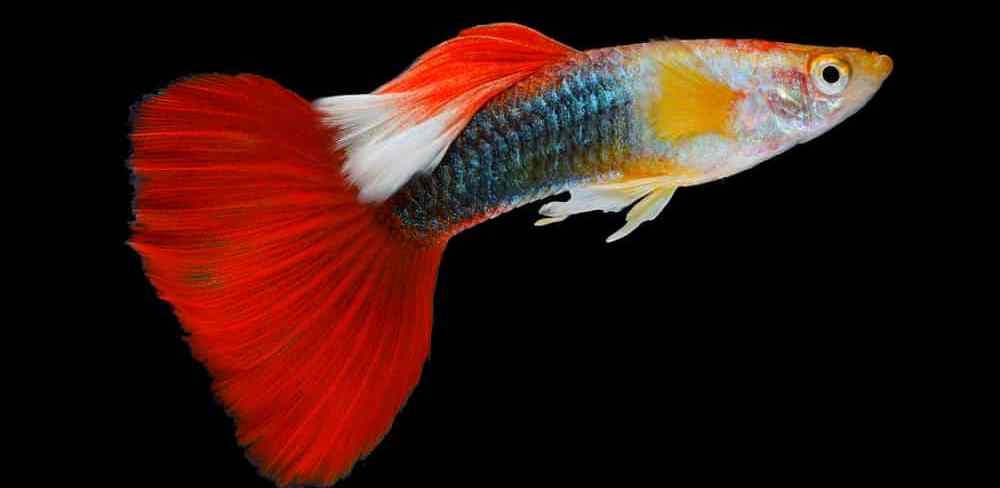
Best On Amazon
Blue Dragon Guppy

I chose this guppy because the colors are amazing! I also liked the contrasing black side fins. Why lower yourself to buying pet store guppies? This is as gorgous a guppy as you can buy. As a bonus the seller specializes in providing guppies to hobbyists.
* Tap here to viisit the seller: D&A Tropical Fish LLC Store
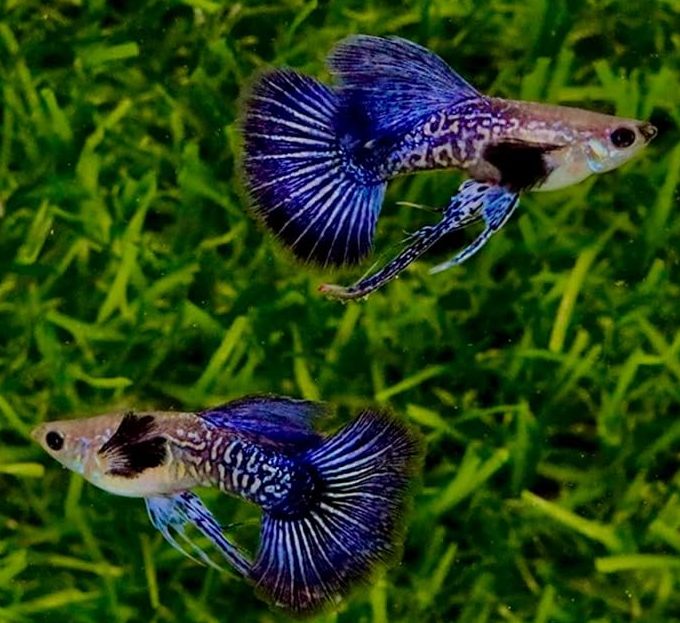
Tap this box to view current price.
Runner up for best on Amazon:
Tiger King Cobra Guppies

Tap this box to view current price.
Mollies
Ease of care: very easy to keep
Image above: Gold Sailfin Molly
Both Molly images are provided by Aquatic Heaven on Amazon. Tap to visit.
Description:
Mollies (scientific name: Poecilia sphenops) are excellent fish for beginners due to how incredibly hardy they are. They are gentle and are unlikely to bully their tank mates. They’re effortless to breed, and their care is easy.
Size:
The Mollies I’ve had have grown to about 4 inches.
Male / Females:
The male Molly has a “gonopodium” underneath their bodies. This is a modified fin used to deposit sperm into the female Mollies body.
Female Mollies don’t have a gonopodium.
Breeding Mollies
Mollies are livebearers, which means they give birth to fully developed, free-swimming young. Because mollies breed easily in your home aquarium, you may soon have more than your tank can handle. You can easily remedy this by keeping mollies with predatory fish like angelfish or other cichlids.
Lifespan:
Mollies may live to be 3 years old. By the time you buy them, they may only have 2 to 2.5 years of life left.
Behavior:
Mollies are gentle easy going fish. They won’t harm your other fish.
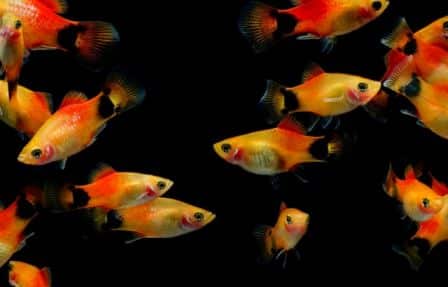
Mollies are available in a wide range of colors, including orange, gold, black, red, green, white, and yellow. Shapes include balloon mollies, sailfin mollies, lyretails, and traditional mollies.
Water conditions:
You should keep mollies in an aquarium of 20 gallons or larger with a satisfactory filtration system. They prefer typical tropical fish temperatures of 72 to 78℉. They accept a wide pH range.
Feeding:
Mollies are omnivorous, meaning they require a diet of both protein and plant-based foods. Since they are omnivorous, they can eat pretty much anything you offer them.
You can feed the mollies any combination of high-quality pellets or flake food, frozen foods, fresh or cooked vegetables, and algae wafers. They are excellent beggars, so be careful not to overfeed.
Feeding Warnings
Warning #1: Be aware that bloodworms are dangerous to fish. I’ve experienced fish dying as a result of feeding them bloodworms. Don’t feed bloodworms, dried or especially frozen, to fish.
Warning #2: When you reach the end of a container of fish food and there is only debris and dust, throw that away. The fish can’t eat the dust, and it can get in their gills.
Aquascape:
Mollies don’t care what the tank looks like. Like most fish they usually only care about their next meal.
Original habitat:
Mollies can be found from Mexico down to Columbia.
Fascinating fact:
Mollies can survive in both saltwater and freshwater aquariums. Saltwater aquarists are now breeding and raising mollies in saltwater tanks for their sale.
Buying Mollies:
Mollies are always available where fish are sold. The last time I bought mollies they cost me about $7 per fish. Amazon has them for about $6 each. EBay has Mollies priced as high as $350 pair.
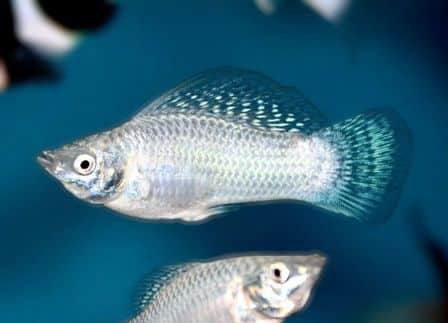
Platies
Ease of care: very easy to keep
Salt and Pepper Platy
Image above is provided by the Amazon store, “Aquatic Heaven.“
You can purchase this platy by tapping here.
Description:
Platies or Platyfish (scientific name: Xiphophorus maculatus) are another “live-bearing” freshwater fish.
Size:
Platies grow up to 3 inches long.
Males / Females:
Male Platies have a “gonopodium” underneath their bodies. This is a modified fin used to deposit sperm into the female Platies bodies.
Lifespan:
Platies will live 3 to 5 years depending on the care.
Behavior:
Their unique characteristics, such as their non-aggression and peaceful nature, make them a favorite among aquarists. For sure a contender for the top 20 best aquarium fish for beginners.
Colors:
Platies are widely recognized as some of the most vibrant freshwater fish. Common colors include blue, red, orange, yellow, and mixed colors. Platies are known by various names related to their colors, including Redtail Platy, Hawaii Platy, Yellowtail Platy, Marigold Platy, Rainbow Platy, and Sunset Platy.
Breeding Platyfish
Platies are livebearers, which means they give birth to fully developed, free-swimming young. Because mollies breed easily in your home aquarium, you may soon have more than your tank can handle. You can easily remedy this by keeping platies with predatory fish like angelfish or other cichlids.
Water conditions:
Each platy you keep should have at least 13 gallons of tank space. Change 50% or more of your aquarium water every week for happy, healthy fish. Platies are tropical fish and prefer water temperatures of 72°F to 78°F with a pH of 7.0 to 8.3.
Cost:
In fish stores and online the cost is roughly $7 per fish.
Feeding:
Platies are omnivores, meaning they need a mix of veggies and protein-based foods. Of course, they will probably accept anything edible that you throw in their tank. You can feed your platies high-quality pellet food, commercial flake supplemented with fresh vegetables, brine shrimp, spirulina algae tablets, and frozen fish foods.
Aquascape:
Like mollies, platies don’t care what the tank looks like. Like most fish they usually only care about their next meal.
Original habitat:
Platies originate in the Southern Part of the United States and the Northern part of South America. (Source: Wikipedia)
Fascinating fact:
Platies / Platyfish are native to the Southern part of North America and South America.
Buying Platies:
Platies are almost always available in pet stores and always available online.
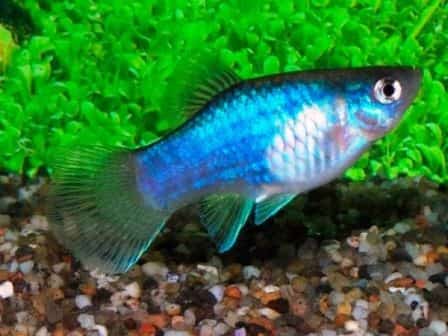
Female Blue Platy
Image above is provided by the Amazon store, “Aquatic Heaven.“
You can purchase this platy by tapping here.
If sold, you can see all Aquatic Heaven’s Platies by tapping here.
Small Plecos
Ease of care: easy to keep
Image above: captive bred Zebra Plecostomus
13 things to know about caring for your pleco plus a warning…
Having kept a couple of different types of Plecostomus, here are a few things I know personally:
Warning: Some plecos get BIG (up to 18 inches). In my view, they not only grow too large but also appear unattractive. Other aquarists think this too. Aquarists in Florida, who no longer want the big, ugly fish in their tanks, have released Plecostomus fish into the wild. As a result, Plecostomus fish have become invasive, overtaking native Florida fish in waterways and lakes.
To avoid the “big and ugly” problem, buying the smaller (often more expensive) specialty plecos is a beneficial idea.
Description:
This is a catfish with a sucker mouth. The fish is covered with hard plating and a high, sharp central fin on its back.
Size:
Small size plecos may get up to 7 inches in length although 4 to 5 inches is more common.
Male / Females:
Can be hard to tell the difference betweem male and female plecos, except for the Bristlenose pleco (males have bristles, females don’t).
Lifespan:
I’ve read that they live up to 15 years. Until I have scientific proof I will say 5 years is more likely. Bottom line they probably live from 5 to 15 years.
Behavior:
Plecostomus fish in an aquarium typically exhibit aggressive behavior toward other Plecos while remaining relatively gentle with their tankmates. However, they will aggressively pursue fish eggs from any egg-laying spawning pairs.
Colors:
Colors available include, but are not limited to Brown, dark orange to red, brown with white stripes, brown with yellow dots, and zebra color (black and white).
Breeding
Plecos are egg layers, and they usually spawn in caves and lay a large volume of eggs on flat surfaces. The male then guards the cave until the eggs hatch. Some plecos are very easy to breed, some are nearly impossible.
Bristlenose Plecostomus fish can reproduce in an aquarium with proper care, a male and female, and a suitable cave for laying eggs. The eggs freely turn into fry that the parents protect. If protected from predators, you will soon have a tank full of adorable little plecos.
Water conditions:
Plecostomus fish prefer water temperature to be 72°F to 84°F and water pH to be between 7.0 and 8.0.
Cost:
A smaller, more desirable pleco can carry a significant price tag. In searching for Zebra plecos (adult sizes 3–4 inches), I found that the average price is $300. A less expensive, smaller Plecostomus to try is the Bristle Nose Plecostomus. I have a female bristlenose pleco in my 30-gallon aquarium, and I can highly recommend them. My female Bristlenose Pleco cost about $20.
Feeding:
Most Plecostomus are known as “algae eaters,” which means they are herbivorous. Some Plecostomus are carnivorous, and they will eat invertebrates, crustaceans, and smaller fish.
My bristlenose pleco will only eat protein (carnivore)-based foods. She will turn up her bristly nose at veggies and veggie tablets.
Most plecostomus fish will eat just about any food that falls to the bottom of the tank but love chewing on algae tablets. They will eat any veggie you feed them, including shelled peas, lettuce, cucumbers, spinach, and zucchini. Cooking the veggies helps them settle at the tank bottom for your plecostomus.
Aquarium set up and care:
You should keep small plecostomus fish in a lightly stocked aquarium of 30 gallons or more. You don’t want too many other fish in the tank, as plecos are messy and poop a lot! You’ll want a large and robust filtration system to help control their mess and waste. You’ll also want to change at least 20% of the water every week. When I kept plecos, I would change 50% of the water weekly.
Some plecostomus like to chew on wood. Put a picce of driftwood in your tank to see if your pleco is one of those.
Original habitat:
South America is the native home of Plecostomus species, although Costa Rica and Panama in Central America also host some of them. In their natural habitat, most plecos live in fast-running, shallow rivers and streams.
Fascinating fact:
Bristlenose Plecostomus fish can reproduce in an aquarium with proper care, a male and female, and a suitable cave for laying eggs. The eggs freely turn into fry that the parents protect. If protected from predators, you will soon have a tank full of adorable little plecos.
Buying Plecos:
Big and ugly plecos can be bought in any pet store that sells fish. They are cute when you buy them. If you see a brown pleco not being sold as a Bristlenose Plecostomus, that cute little pleco will grow up to be the big and ugly kind
If you want an attractive pleco that will stay reasonably sized you will probably need to look online.
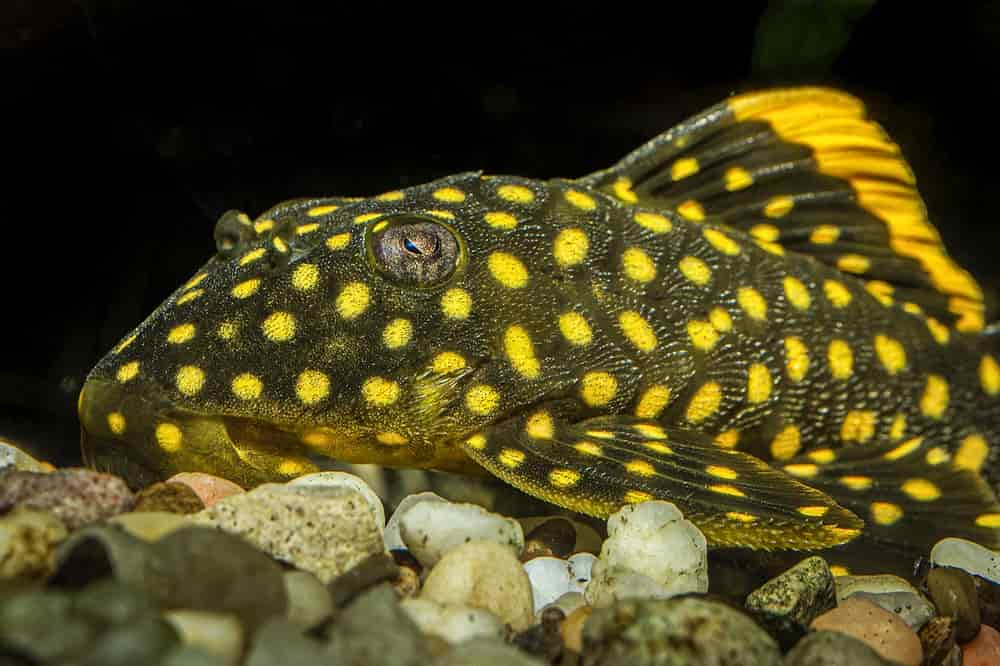
Angelfish
⇒ I have an extremely good article about Angelfish on this page Tap Here.
Pterophyllum scalare – Most common. There are three distint species of Angelfish.
Ease of care: very easy to keep

Description:
Angelfish are slim fish with large fins that kind of look like a rocket ship. Angelfish are so popular that they had to be in the running for the best aqauarium fish for beginners. Angelfish are admired due to their beautiful swimming behavior and how easy they are to care for. They would be a perfect addition to your large community aquarium.
Size:
Angelfish grow 4 to 7 inches wide and tall. I’ve read that they can get up to 12 inches but I’ve never been seen an Angelfish that large.
Male / Females:
It’s a bit hard to tell the difference between male and female Angelfish until they lay eggs. When breeding, the female will have a small tube on their abdomen where the eggs come out.
Lifespan:
They could live up to ten years when well cared for.
Behavior:
Angelfish behavior is usually gentle, but they can become aggressive and territorial when a pair is spawning.
Colors:
Angelfish are available in different colors such as yellow, golden, platinum black, silver, etc. Angelfish are available in many color variations, such as silver, koi, zebra, black lace, golden, dusky, blushing marble, half black, blue, and golden marble angelfish.
Wild bred angelfish can be purchased online and are available in silver color with dark or black vertical stripes.
Breeding
Mature angelfish create monogamous pairs if there is a male and female in your tank. Angelfish eggs are laid on a vertical surface such as a flat leaf, wood, or even aquarium glass. When the eggs hatch, angelfish fry will remain where laid until they are free-swimming.
To ensure the pair don’t eat the eggs do 3 things:
1) Give them a tank to themselves.
2) Give them low level lighting.
3) Ensure the ph of the water is 6.0 or lower. Miss any of these three and most assuredly they will eat their eggs.
Water conditions:
- Angelfish can adapt to your tap water as long as it’s drinkable (I.E. your water isn’t toxic).
- Set the water temperature at 78 degrees F. or 25 degrees C.
- If you want to provide your angels with water similar to water in the wild, you would use reverse osmosis water (soft water) and maybe some sphagnum moss to help lower the pH.
Cost:
At your local fish store or online one angelfish runs from $10 to $45.
Feeding:
Angelfish are omnivorous and will eat just about any fish food you provide them. They’ll eat flakes, small shrimp, food granules, small food pellets, frozen food like brine shrimp.
Note #1 on feeding: Be aware that bloodworms are dangerous to fish. I’ve experienced fish dying as a result of feeding them bloodworms. Don’t feed bloodworms to fish.
Note #2 on feeding: When you reach the end of a container of fish food and there is only debris and dust, throw that away. The fish can’t eat the dust, and it can get in their gills.
Aquascape:
Anything that helps lower the pH is good.
You want to create a low pH environment because in the Amazon, rotting plant debris falling into the water release humic Acid (notice the use of the word acid) and tannins (acidic chemicals found in plants). These two chemicals lower the pH of the water the Angelfish are living in.
Another side effect of the rot is the creation of Black Water. Black Water will be brown to black. This is due to tannins releasesd by the plant debris.
Aquarists can observe the blackwater effect by adding driftwood to their aquarium. The wood will turn the water a tea color and probably lower the pH slightly.
Other plant materials sold for aquariums to lower pH are Sphagnum Moss, Indian Almond Leaves, Mulberry leaves and Oak Leaves.
Original habitat:
Slow moving steams in the Amazon River Basin
Fascinating fact:
In nature Angelfish live in water where pH may be also low as 3.0. Vinegar has a pH of 2.5 to 3.
Buying Angelfish
Angelfish are readily available where aquarium fish are sold.
My pick for Best On Amazon for "Angelfish":
Koi Pearlscale Angelfish

Choice was based on:
* Excellent pearlscaling and koi colors (orange and black).
* Seller has grown these angelfish out somewhat more than usual.
* Sellers has consistently good reviews - Quinns Fins
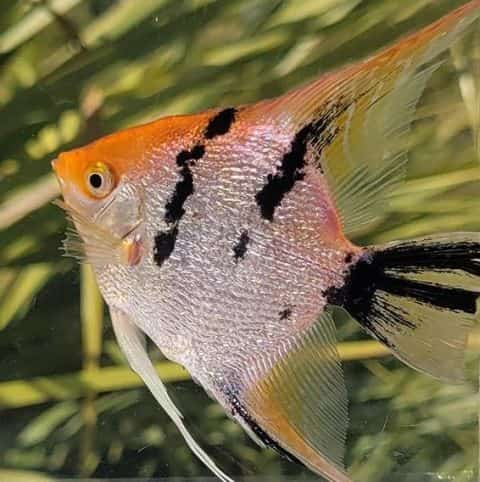
Tap this box to view current price.
Then look for "All buying options box"
Corydora Catfish
Ease of care: challenging easy to medium.
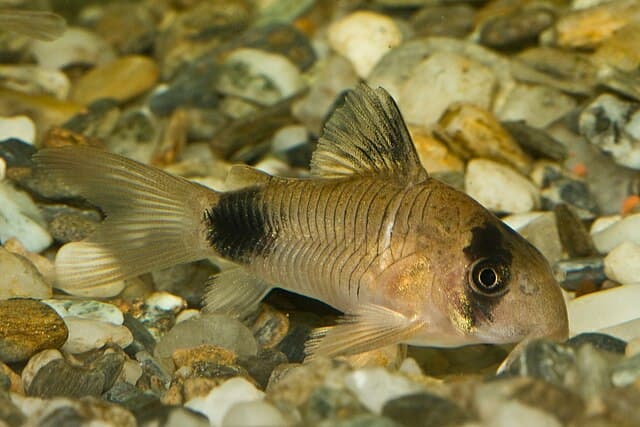 Image above: Panda Corydora
Image above: Panda Corydora
Description:
Corydora Catfish are small bottom dwelling catfish.
They would win the award for cutest fish, if there was a contest.
Corys are a schooling fish, so buy as many your aquarium can handle (or at least 10).
Size:
Adult corys grow to about 3 inches, give or take.
Male / Females:
Corydoras are difficult to sex however female Corys often have a more rounded abdomen and are somewhat plumper than male.
Lifespan:
Corydoras live five to ten years when well cared for. I’ve read that it is possible for a cory to live up to 20 years.
Behavior:
This fish’s sweet disposition, and gentle temperament makes them ideal for a beginners
Colors and types:
Cory’s are available in different colors such as green, black, albino, and bronze. Wikipedia shows 171 different variations of Corydora Catfish.
Breeding
Cory catfish are egg depositors. These catfish breed in groups, such as two males to one female. The breeding tank should have many live or fake plants.
To raise the fry follow the general directions of any egg depositing fish.
Water conditions:
Cory Cats prefer a water pH of between 6.8-8.0 and water temperatures typical of tropical fish; 78 degrees F. or 25 degrees C.
Cost:
Petco has them priced between $5 and $12. Online prices run from $10 to $20.
Feeding:
Cory catfish are omnivores, and they can eat both plant and animal matter. Shrimp pellets, feeder tablets, algae rounds, tropical granules, and live foods are excellent choices for Cory cats.
Warning #1 on feeding: Be aware that bloodworms are dangerous to fish. I’ve experienced fish dying as a result of feeding them bloodworms. Don’t feed bloodworms to fish.
Warning #2 on feeding: When you reach the end of a container of fish food and there is only debris and dust, throw that away. The fish can’t eat the dust, and it can get in their gills.
Aquascape:
Most important is substrate. Sand or coated gravel. Don’t use gravel with sharp edges.
Original habitat:
Various countries in tropical South America.
Fascinating fact:
As mentioned above Corys can live up to 20 years. In addition Wikipedia shows that there are at least 171 types of Corydora Catfish identified so far.
Buying Corydora Catfish:
Corydoras are readily available on line and in local pet stores that sell fish.
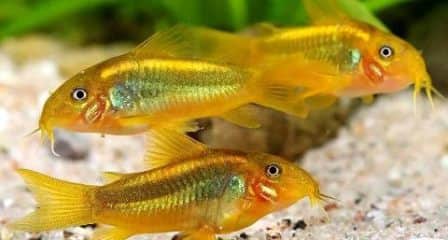
Image above: Gold Laser Cory
Image provided by Neat & Tidy an Amazon seller.
My pick for Best On Amazon for "Corydora Catfish":
Sterbai Cory Catfish

Choice was based on:
* Excellent & strong colors).
* Beautiful & somewhat unusual markings.
* Sellers has good ratings and reviews - Neat&Tidy Store
Tap this box to view current price.
Rainbow Fish
Ease of care: easy to keep
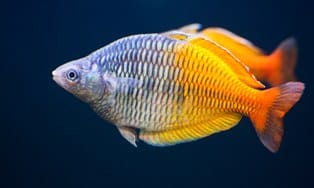
Description:
The peaceful Rainbow fish, belonging to the family Melanotaeniidae, are a dazzling array of freshwater species known for their brilliant iridescent colors that shimmer like a living rainbow.
Size:
Generally 2 to 5 inches in length.
Male / Females:
Rainbow fish males are usually colored more brightly and have a more streamlined body.
Females are a bit chubbier and have more muted colors.
Lifespan:
It is said that Rainbow Fish live live 6 to 8 years. I would need scientific research to prove this to me. In the mean time we will go with 6 to 8 years.
Behavior:
Gentle personality. The males can be a bit aggressive when mating.
Colors and types:
Rainbowfish colors include red, yellow, silver, blue, and orange. A few of the different kinds of Rainbowfish are Australian Rainbowfish, Boesemani, Axelrod, Celebes, Praecox, Threadfin, Red Irian, Pseudomugil, and Turquoise.
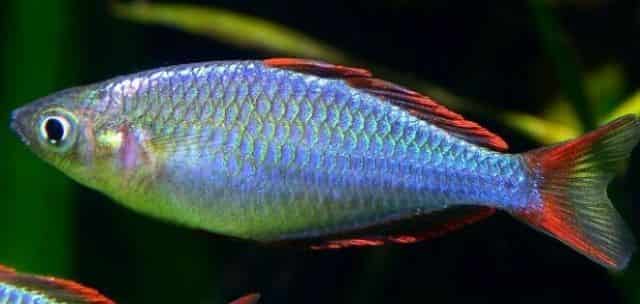
Image above: Praecos Rainbow Fish
Breeding
Rainbowfish are very easy to breed. They are egg scatterers. When you want to reproduce this fish, raise the breeding tank temperature by 2 or 3 degrees. This will increase the spawning activity. These fish court in the early morning and then spawn at the first light. The adults should be removed after the eggs have been laid.
Give appropriate food to baby fish after they start swimming freely.
Water conditions:
30 gallons or larger tank per fish is suitable. Don’t over stock. Proper water temperature for rainbowfish is between 74 and 78°F, while the preferred pH would be between 7.0 to 8.0.
Cost:
Petco has them priced between $8 and $12. Online they are priced from $10 to $40 each.
Feeding:
Rainbowfish are omnivorous. They will eat floating vegetation, cooked and canned veggies, protein-based flakes, tablets, live foods, and more.
Warning #1: on feeding: Be aware that bloodworms are dangerous to fish. I’ve experienced fish dying as a result of feeding them bloodworms. Don’t feed bloodworms, dried or especially frozen, to fish.
Warning #2: on feeding: When you reach the end of a container of fish food and there is only debris and dust, throw that away. The fish can’t eat the dust, and it can get in their gills.
Aquascape:
Hobbyist’s choice.
Original habitat:
Rainbowfish (Melanotaeniidae) inhabit eastern and northern Australia, the islands of Raja Ampat in Indonesia, the islands of Cenderawasih Bay, and New Guinea.
Rainbowfishes natural habitats are large, slow-moving bodies of water, including lakes, rivers, and swamps.
Fascinating fact:
Rainbow fish come in a very large variety of colors.
Buying
Rainbow fish are readily available in pet stores and online
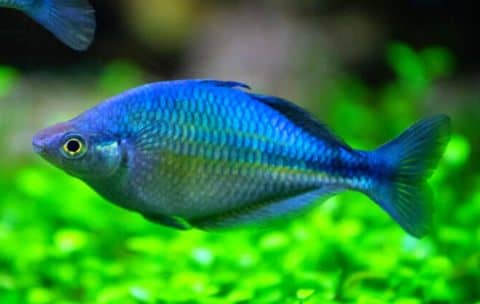
Above: Rainbow Fish
Image provided by Neat & Tidy an Amazon seller.
Interested in owning this fish? Tap here.
Video: Incredible rainbow fish movie. Tap image to view movie.
Gold Fish
Ease of care: Challenging easy to medium difficult. This is due to the fish needing cool to cold water and a clean tank to stay healthy.
⇒ Super Important Fact About Goldfish:
They must be kept in cool to cold water. Do not put them in with your tropical fish. They will slowly die from that environment.
Please be kind.
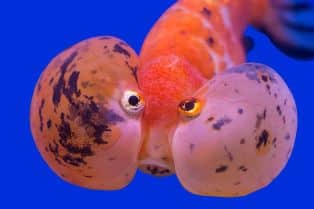
Description:
The Goldfish (Carassius Auratus), is a freshwater fish that belong to the fish family of Cyprinidae. They are one of the most exciting fish for your aquarium. Goldfish species have been bred to extremes. Varieties include bubble eyes, brainheads, super fat bodies, and more.
Size:
Generally aquarium Goldfish (fancy) grow to be 6 to 8 inches in length.
Male / females:
It’s difficult to tell a female from a male Goldfish.
Lifespan:
A healthy Goldfish that is kept in a clean cool to cold environment will live 15 to 20 years. 30 or more years is not unheard of.
Behavior:
Goldfish have a very gentle personality.
Colors and types:
Since Goldfish have been bred for over 2000 years there are many different types in many different colors.
Goldfish colors include yellow, white, orange, calico, black, and red. There are many variations such as wakin, veiltail, comet, fantail, shubunkin, and much more.
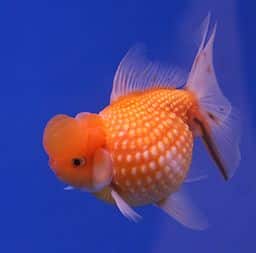
Image above: Show Quality Pearl Scale Goldfish
Breeding
Place the female and male goldfish within the same tank. An outdoor plastic swimming pool works much better than trying to breed them in an aquarium. Then you must wait for the female to drop her eggs and for the male to fertilize them.
When the eggs are fertilized, transfer both adult goldfish into a different tank, so they don’t eat the eggs. The eggs will hatch out in four to seven days, with the fry becoming free-swimming at hatching.
Water conditions:
Here is how I would set up the water conditions. First and foremost temperature. My folks had a pond with goldfish living in it. In the winter time the pond would freeze over. This never harmed the goldfish.
Based on this my recommendation is to keep the goldfish tank in an unheated basement. If you have a fan blowing across the surface of the water 24/7 this will cool down the water significantly.
PH from 7 to 8 is fine.
Cost:
Petco has fancy Goldfish priced at about $30. Online they are priced from $30 to $500 each. (Yes, $500)
Feeding:
You can feed your goldfish canned and boiled vegetables such as carrots, peas, and zucchini. You can also feed them shrimp, and other live foods. They are always hungry, so they will eat just about any fish food they are given.
Warning #1: on feeding: Be aware that bloodworms are dangerous to fish. I’ve experienced fish dying as a result of feeding them bloodworms. Don’t feed bloodworms, dried or especially frozen, to fish.
Warning #2: on feeding: When you reach the end of a container of fish food and there is only debris and dust, throw that away. The fish can’t eat the dust, and it can get in their gills.
Aquascape:
Aquarist choice. Watch for sharp edges to keep injuries to a minimum.
Original habitat:
The Goldfish is native to East Asia. Natural Goldfish habitats are slow streams and lakes.
Fascinating fact:
To me, the most fascinating fact about Goldfish is that they can handle water temperatures just above freezing.
Buying
Although you can buy Goldfish at your local pet store, don’t. You’re going to have your Goldfish around for 15 or more years, you might as well buy the best. Buy from a fish seller online.
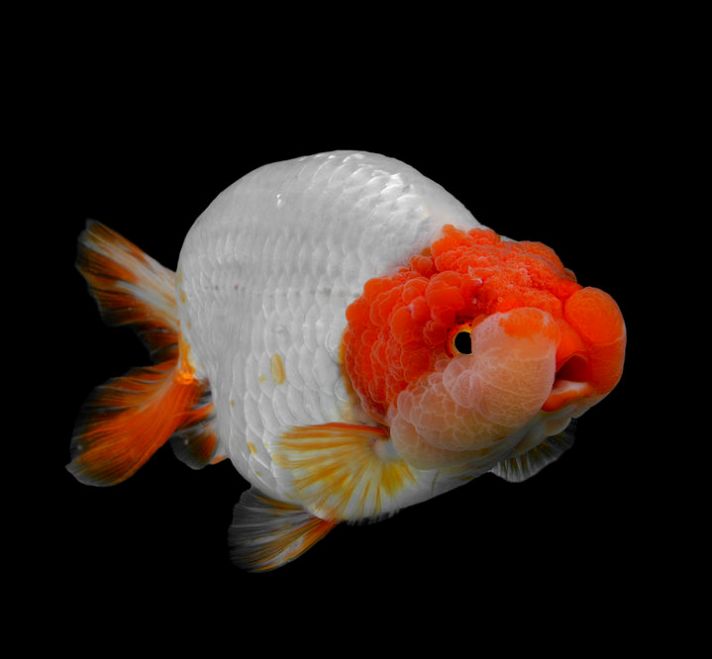
My pick for Best On Amazon for “Fancy Goldfish”:
4″ Golden Oranda Goldfish

Choice was based on:
* Good colors and good head crest.
* At 4 inches, this is not a small fish. You are getting a nice sized Goldfish.
* This fish has good reviews: out of 42 ratings, 81% of buyers give 4 or 5 stars.
Tap this box to view current price.
Bristlenose Plecostomus / Bushynose Plecostomus
Ease of care: very easy
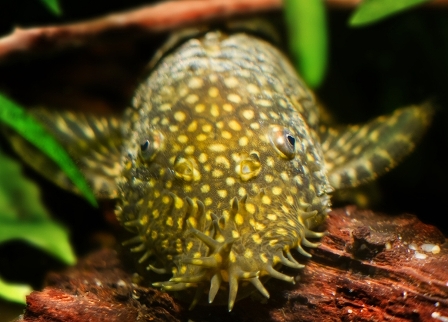
Description:
I have a female Bristlenose plecostomus in my community tank. She is very shy.
We can best describe Bushynose Plecos as alien, mysterious, and unique.
They have a fascinating “tentacle-covered” mouth (males), but there is more to this fish than just tentacles.
Bristlenose plecos have been a favorite aquarium fish for a long time. This is probably because of their small size, their calm demeanor, and their low maintenance requirements. Plus they are so weird looking.
Considering one as a pet? I will tell you what you should know about this unique fish.
Size:
5 inches is about average.
Male/Females:
It’s not easy to distinguish male and female Bristlenoses while young, but they develop full sexual characteristics once they reach full adulthood.
Males of the species display longer bristles, and they grow all over their heads. In contrast, females only develop smaller tentacles around their snout. . Depending on the species, males may develop tentacles near the pectoral fin, though this isn’t common.
Lifespan:
Bristlenose plecostomus will live from 7 to 15 years.
Behavior:
Bristlenose Plecostomus are peaceful. Mine likes to hide, only showing itself occasionally.
Colors and types:
You can find these fish in albino, black, brown, and grey colors. Some have white or gold-colored dots covering their bodies.
Breeding
Bristlenose plecostomus are fairly simple to breed in a breeding aquarium. The pair will need an artificial “cave” to lay eggs in. You can look online for caves or make your own with a half of a terra cotta pot. Once the eggs have been laid, the female is done with her “duties” and should be removed from the breeding tank. The male Bristlenose will guard the eggs and fry.
Water conditions:
Standard tropical fish conditions: Preferred water temperature is 75 degrees to 80 degrees. Recommended pH for the Bristlenose Plecostomus is 6.5 to 7.5.
Cost:
Rare types range from $15 to $50.
Feeding:
In the wild, their diet consists mostly of algae and a biofilm-like substance called aufwuchs, which consists of algae, bacteria, microbes, and other protein-rich small animals that thrive on the surface of stones and wood.
Having raised plecos in the past, the first “food” I would tell you to buy is a good-sized piece of driftwood. Plecostomus fish will constantly chew on the wood in their aquarium.
I feed my Bristlenose protein-based foods directly before I go to bed. I put just enough into the aquarium to fill her stomach.
The foods I use include API bottom feeder fish pellets with shrimp, Ultafresh tropical shrimp pie tablets, Fluval bug bites (dried insect larvae) formed into a mashed wet ball, canned fresh mosquito larvae, and frozen brine shrimp.
In addition, my Bristlenose plecostomus apparently eats Ramshorn snails. I throw them in, and they disappear, shell and all. I know it’s not my Tiger Barbs eating them because the barbs leave the shell.
Warning #1: on feeding: Be aware that bloodworms are dangerous to fish. I’ve experienced fish dying as a result of feeding them bloodworms. Don’t feed bloodworms, dried or especially frozen, to fish.
Warning #2: on feeding: When you reach the end of a container of fish food and there is only debris and dust, throw that away. The fish can’t eat the dust, and it can get in their gills.
Aquascapes:
Provide plenty of places to hide.
Original habitat:
“Amazon Basin” pretty much sums it up.
Fascinating fact:
The most interesting fact is that the males have the bristles. The females almost never do. Another fascinating fact is that the males guard the eggs and fry (babies).
Buying
You can often find a limited selection in a pet store. If you are interested in something other than brown, you will need to shop online.
The Bristlenose Plecostomus: A Quirky Addition to Your Aquarium
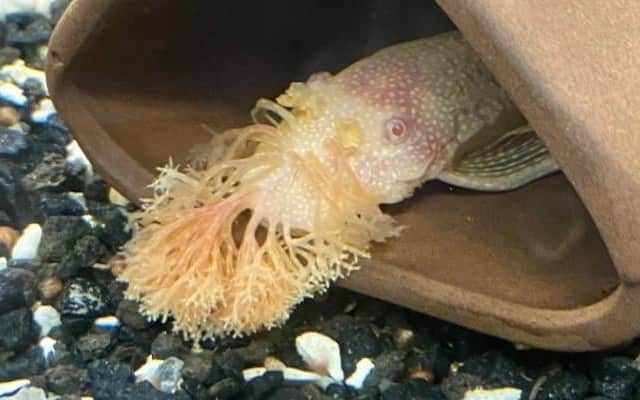

Kuhli Loach
Ease of care: very easy
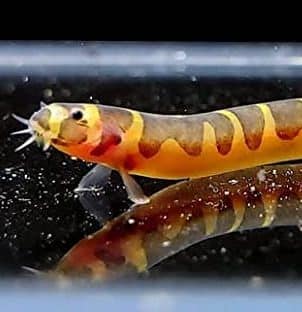
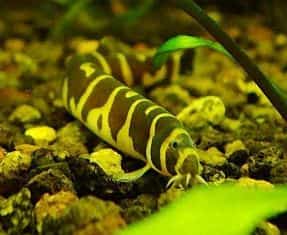
Description:
The kuhli loach is an unusual-looking fish appearing more like an eel than a fish. It is timid and nocturnal. It will hide using the aquarium ornaments or by digging into the substrate.
Kuhli loach (Pangio kuhlii) is also known as leopard loach, coolie loach, or cinnamon loach.
Size:
4 inches is about average.
What is the difference between males and females?
Basically impossible to tell.
Lifespan:
A kuhli loach will live from 7 to 15 years.
Behavior:
This fish is shy, easily frightened, and is nocturnal. Based on this, you probably will rarely see the kuhli Loach in your aquarium.
Colors and types:
Yellow/orange and brown, albino, brown/red, no markings
Breeding
Only experienced large-scale breeders will be able to breed kuhli loaches.
Water conditions:
Standard tropical fish conditions.
Cost:
$3 up to $15 each
Feeding:
Kuhli loaches are omnivorous and feed on what falls to the bottom of the aquarium. They enjoy flakes, pellets, mosquito larvae, and brine shrimp. They require feeding, as they are not trash fish. Being nocturnal, you will feed them right before you go to bed.
Warning #1: on feeding: Be aware that bloodworms are dangerous to fish. I’ve experienced fish dying as a result of feeding them bloodworms. Don’t feed bloodworms, dried or especially frozen, to fish.
Warning #2: on feeding: When you reach the end of a container of fish food and there is only debris and dust, throw that away. The fish can’t eat the dust, and it can get in their gills.
Aquascaping:
Provide plenty of places to hide. Don’t use gravel with sharp edges because they dig through the gravel.
Original habitat:
They are native to the Malay Peninsula and Indonesia, where they inhabit slow-running waters and forest streams.
Fascinating fact:
They look like worms, and they act like worms in your aquarium. They dig through the gravel most of the time, when they’re not in hiding.
Buying
Usually available in local pet stores. Always available online.
Cherry Barb
Ease of care: very easy
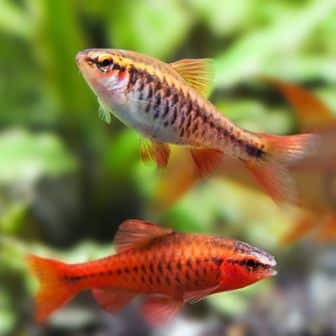
Description:
The cherry barb (Puntius titteya) are popular because of their color, their schooling behavior, and because they are lively and easy to care for. Exactly what we are looking for in a fish to be added as the best starter aquarium fish for beginners.
Size:
This fish grows to be 1.5 to 2 inches.
What is the difference between males and females?
Males tend to be brighter with more vibrant colors.
Female cherry barbs have more subdued colors and are usually plumper.
Lifespan:
Cherry barb fish typically have a lifespan of 5 years.
Behavior:
Cherry barbs are peaceful and get along well with other fish in a community aquarium.
Colors and types:
Cherry barbs are red-to-pink. There are also albino cherry barbs available.
Breeding
Cherry barbs are egg scatterers. Female cherry barbs will lay 200 to 300 eggs scattered on the aquarium substrate and plants. As they lay the eggs, the male cherry barb fertilizes them. Once the parents have finished spawning, remove them from the breeding tank. The eggs will hatch within one or two days. The fry become free swimming two days after hatching.
Water conditions:
Typical tropical aquarium parameters are fine.
Cost:
$3 to $8 each
Feeding:
Cherry barbs eat most anything you give to them that they can fit in their mouths. These foods include small insects, crustaceans, algae, diatoms, worms, zooplankton, brine shrimp, flake food, and more.
Feeding Warnings
Warning #1: Be aware that bloodworms are dangerous to fish. I’ve experienced fish dying as a result of feeding them bloodworms. Don’t feed bloodworms, dried or especially frozen, to fish.
Warning #2: When you reach the end of a container of fish food and there is only debris and dust, throw that away. The fish can’t eat the dust, and it can get in their gills.
Aquascaping:
Aquarist’s choice.
Original habitat:
Sri Lanka – Cherry barbs come from Sri Lanka, where you can find them swimming around in the streams and little ponds of the rainforest. The loss of their habitat is putting them in danger of disappearing in the wild.
Fascinating fact:
Cherry barbs can change colors based on their mood and environment. When they’re satisfied and content, their colors are vibrant, displaying shades of deep red, orange, and yellow. However, when they’re stressed or frightened, they can turn paler to blend in with their surroundings.
Buying
Cherry Barbs are usually available in local pet stores and always online.

Neon Tetra Warning
Ease of care: Nearly impossible – I originally had neon tetras here but removed the posting as I learned more. They are always available in pet stores, so you would think they must be an easy fish. Nope. Due to neon tetra disease and the exacting conditions needed to keep them healthy, I now consider them very difficult to keep for a beginner.
Don’t buy this fish; they won’t live more than a few months in a regular aquarium setup. Why waste your money when there are so many fish that will live a long time in your aquarium?
White Cloud Minnow
Ease of care: very easy

White Cloud Minnow – courtesy of Wikipedia
Description:
White cloud minnows (Tanichthys Albonubes) are a cool water fish that can tolerate tropical water temperatures. They are native to China, where they inhabit cool river areas.
White Cloud Minnows are almost extinct in the wild due to pollution and encroachment on their environment by humans.
Size:
1.5 inches at maturity
What is the difference between male and females:
Males will show brighter colors particularly during mating.
Females will be somewhat plumper than the males.
Lifespan:
This fish will live about 5 years.
Behavior:
White cloud minnows are friendly and peaceful.
Colors and types:
In general there are the traditional colors (see image above) and a golden color (see image below). There are also small variations in between those two color patterns
Breeding
It is easy to breed white cloud minnows. To breed white cloud minnows feed them high nutrition live food such as daphnia and brine shrimp.
White clouds are egg scatterers; they drop their eggs freely among the vegetation and gravel. The eggs will hatch within two or three days. White cloud minnows do not cannibalize their eggs. Because of this, adults can be left in the breeding tank after spawning.
Water conditions:
Temperatures of 60 to 70 degrees F. This fish can tolerate tropical fish temps. Nuetral pH.
Cost:
$2 to $5 each
Feeding:
White Cloud Minnows eat most anything you give to them that they can fit in their mouths. These foods include small insects, crustaceans, algae, diatoms, worms, zooplankton, brine shrimp, flake food, and more.
Feeding Warnings
Warning #1: Be aware that bloodworms are dangerous to fish. I’ve experienced fish dying as a result of feeding them bloodworms. Don’t feed bloodworms, dried or especially frozen, to fish.
Warning #2: When you reach the end of a container of fish food and there is only debris and dust, throw that away. The fish can’t eat the dust, and it can get in their gills.
Aquascape:
Aquarists choice but if possible keep with other cool water fish like goldfish
Original habitat:
Far South East China
Fascinating fact:
I think the most interesting fact about this fish is that it is a cool water fish that can be kept in a tropical temperature fish tank.
Buying:
Usually available in pet stores. Always available online.
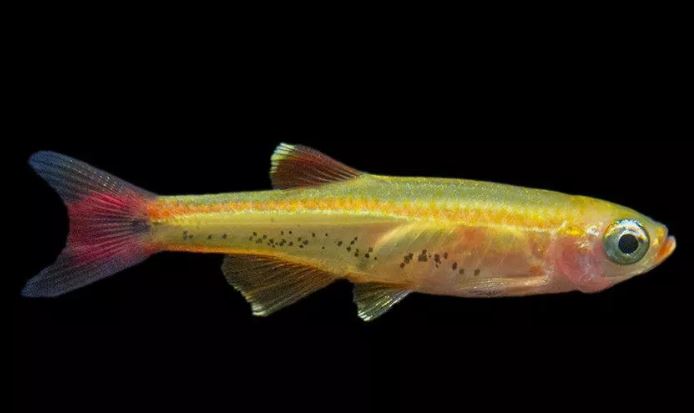
Zebra Danio
Ease of care: very easy.
Save this zebra danio section to your favorites:
* Using a PC drag and drop section link below into your favorites.
* On smart phones tap the link and then save to favorites.
Zebra Danios
This Section Is Interactive:
Each zebra danio image has a link to a unique or unusual aquarium video. Tap to find out where the link leads you.
- Description:
The Zebra danio (Danio rerio) is an exciting, active member of any community aquarium. They are simple to care for and perfect for a beginner’s aquarium.
- Size:
Zebra danios grow to about 5 centimeters (1.5 to 2 inches). 1
- What is the difference between males and females?
Males typically have a slightly smaller, thinner body size than females. The male’s body color becomes a golden color when courting the females. 2
- Lifespan:
Zebra danios live two and a half years under normal aquarium conditions. They may live up to five years in pristine tank conditions. 3
- Behavior:
Zebra danios are peaceful, active community fish.
- Colors and types:
Typical zebra danios have alternating dark and white stripes running along the length of the body.
- Breeding
Very easy to breed. Follow advice for egg scatterers. 4
- Water conditions:
Their suggested water temperature is 65 to 75°F. The preferred water pH for the zebra danio is between 7.0 and 8.0.
- Cost:
You can purchase them for $2 to $5 at a pet store. Specialty Danios run about $15 each online.
(Additional Information: Amazon.com, live fish, zebra danios)
(Additional Information: Petco.com, zebra danios)
- Feeding:
Zebra danios eat most anything you give to them that they can fit in their mouths. These foods include small insects, crustaceans, algae, diatoms, worms, zooplankton, brine shrimp, flake food, and more. 5
Fish Food Warnings
Warning #1: Be aware that bloodworms are dangerous to fish. I’ve experienced fish dying as a result of feeding them bloodworms. Don’t feed bloodworms, dried or especially frozen, to fish.
Warning #2: When you reach the end of a container of fish food and there is only debris and dust, throw that away. The fish can’t eat the dust, and it can get in their gills.
 Zebrafish In The Authors 30 gallon tank
Zebrafish In The Authors 30 gallon tank
- Aquascape Types:
Hobbyist choice.
- Original habitat:
Zebra danios are native to South Asia. They inhabit ditches, canals, streams, ponds, lakes, and rice paddies.
- Fascinating fact:
You can keep danios in temperatures as low as 55 degrees F and in water as high as 100 degrees F.
- Buying:
Always available online and in local pet stores.
Videos:
- Video Link: “Unleashing the Chaos: Zebra Danio Care & Breeding Secrets” Is The Zebra Danio Really a Beginner Fish? Care and Breeding
1. Aquarium Industries, Zebra Danio Care Sheet
2. Size: Science Briefss – How you can Tell Male & Female Zebrafish Apart By Erwin van den Burg
3. Lifespan: Age entry for Danio rerio – Human Ageing Genomic Resources – AnAge Database of Animal Ageing and LongevityClassification (HAGRID: 03900
4. Zebra Danio Breeding, Fry Rearing, and Improving Bloodlines – TankScaping – December 10th, 2023
5. Zebra Danio Care, Feeding, Breeding – PlantedAquariumExpert.com
Betta Fish
Ease of care: very easy
Save this betta section to your favorites:
* Using a PC drag and drop section link below into your favorites.
* On smart phones tap the link and then save to favorites.
Betta Fish
Note: All the pictures have a link to cool, surprise betta video.
Description:
Bettas (Betta Splendens) are an easy, fun freshwater beginners fish to keep. They act tough when you get near their tank. They’ll flare their fins and gills as an instinct to scare you away.
They can be stunning, as you can see in this Bing images link or the pictures featured here.
Size:
Most websites say about 3 inches. However for me, with flaired fins, males are about 4 inches and larger. Females will grow to be about 2.5 to 3 inches
What is the difference between males and females?
This is an easy one. Males have the amazing colors and the huge fins. Females coloration is more subduded and their fins are smaller.
Lifespan:
The average lifespan of the Betta fish is three years, but they can live longer.
Behavior:
Betta fish do well in a community tank. Other fish may nip at the Betta’s fins, so be on the lookout for that problem.
Don’t keep other Bettas, male or female, with your Betta because they will fight, which will eventually kill one of them.
Colors and types:
It’s almost easier to talk about what color they’re not. Betta fish are available in various colors such as black, white, pink, green, blue, red, purple, and yellow. This is a start.
Breeding
Breeding Bettas is pretty straightforward, if not easy. Get the female ready to lay eggs by feeding her larger than normal portions of high-quality foods. When a male Betta is ready to reproduce, he will use his mouth to build a large nest of bubbles on the surface of the water. When it seems the nest is as big as he’s going to make it, release the female into the tank. He’ll court her. When she releases her eggs, he fertilizes them and places them in the bubble nest. When spawning seems complete, remove the female betta. Eggs will hatch in two or three days. Remove the male at this time and feed the fry food appropriate for baby fish.
⇒ Wiki Pet information: How to Breed Betta Fish
⇒ Video (1 million views) Breeding Betta Fish in a Tubs (Super Easy!)
Water conditions:
Specific habitat characteristics for a betta population in Thailand are pH of 5.47 (range from approximately 5.28 to approximately 5.80), temperature of 29.9°C (about 86°F on average; range from approximately 27.0 to approximately 31.5°C), and depth of about 5.0 cm (2 inches on average, range from approximately 2.0 to approximately 9.4 cm).
Reference: Askifis Evolution, Culture, and Care for Betta splendens Craig Watson, Matthew DiMaggio, Jeffrey Hill, Quenton Tuckett, and Roy Yanong
Cost:
$15 in petstores. Buy an exceptional one, like in these pictures you see here for $50 to $150 (online).
My thoughts on bettas in cups you see in pet stores:
⇒Video: Why Bettas Being Sold in These Cups is BAD
Don’t buy betta fish in a cup! Don’t encourage the pet stores to do this by buying cupped bettas.
That just encourges pet stores to buy more of those poor fish. That’s just mean.
Feeding:
My bettas have eaten any edible fish food I’ve put in their tank.
Fish Food Warnings
Warning #1: Be aware that bloodworms are dangerous to fish. I’ve experienced fish dying as a result of feeding them bloodworms. Don’t feed bloodworms, dried or especially frozen, to fish.
Warning #2: When you reach the end of a container of fish food and there is only debris and dust, throw that away. The fish can’t eat the dust, and it can get in their gills.
Aquascaping:
Hobbyist choice except the males need gentle water movement.
Original habitat:
Southwest China, Myanmar, Laos, Thailand, Cambodia, and southern Vietnam.
Fascinating fact:
Most hobbyist just think of male bettas, but I’ve found that females are really awesome community fish.
Buying
Always available in pet stores (if they are sold cups, buy elsewhere). Always available online.
African Cichlids
various
Ease of care: very easy
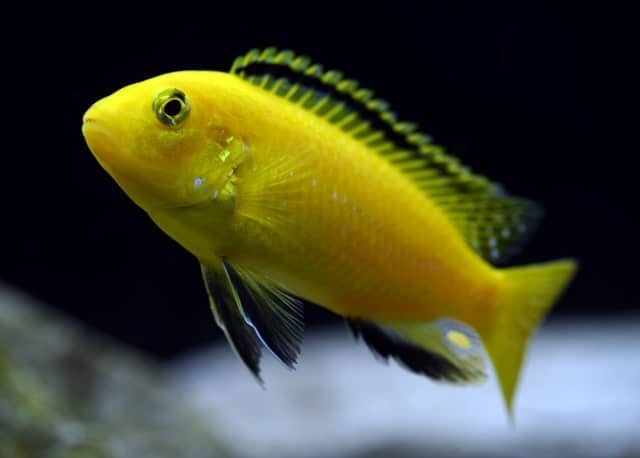
Description:
African cichlid fish are native to three large lakes in East Africa. Choosing an African cichlid fish might be challenging because there are so many choices.
These mostly colorful fish are easy to care for. Beginners will rarely make enough mistakes to kill an African cichlid. They are active swimmers, and their breeding habits are fascinating to watch.
Size:
2 to 6 inches is average. Some grow to 12 inches.
Male / Females:
Generally the males are much more brightly colored than the females.
Lifespan: African cichlids will live from five to fifteen years.
Behavior:
African cichlids can be aggressive and territorial when spawning or caring for their young. Most African cichlids are “mouthbrooders,” meaning they keep their eggs in their mouths until they hatch. The fry will return to the parent’s mouths if they sense danger.

Colors:
African cichlids are available in various color combinations such as orange, yellow, purple, red, pink, blue, and black.
Breeding
African cichlids are mouthbrooders. The male cichlid will dig out a cave or take over a cave. He will then use the cave to entice the female to breed with him. Female cichlid lay eggs in the cave, and then after the male cichlid has fertilized them, she will take the eggs into her mouth. She will keep the eggs in her mouth until they hatch in 21 days.
Water conditions:
The minimum tank size required for the African Cichlid is 30 gallons. Don’t overstock your aquarium! The preferred water temperature is 73 to 82°F with a pH of 7.8 to 8.5, which is fairly high. If you come from an area with soft water, you will need to adjust the pH.
Feeding: African cichlids will eat anything you put in their tank, from flakes to tablets and frozen foods to live foods.
Cost:
In a local pet store you will probably pay $8 to $15. Online you will spend $15 to $40 or sometimes more.
Aquascape:
The natural habitats have a lot of sand and rocks. You can’t go wrong with lots of rocks as your aquascape for your African Cichlids.
Fascinating fact
Mouth brooding is common. Mouth brooding consistants of keeping eggs and protecting the fry in the adult mouth.
Buying
Always available online and in local pet stores.
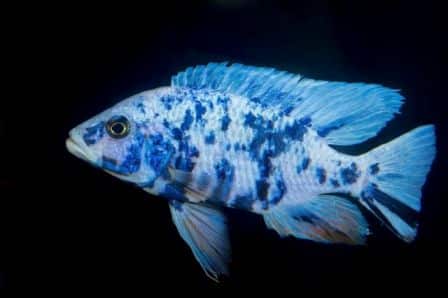
Harlequin Rasboras
Ease of care: very easy
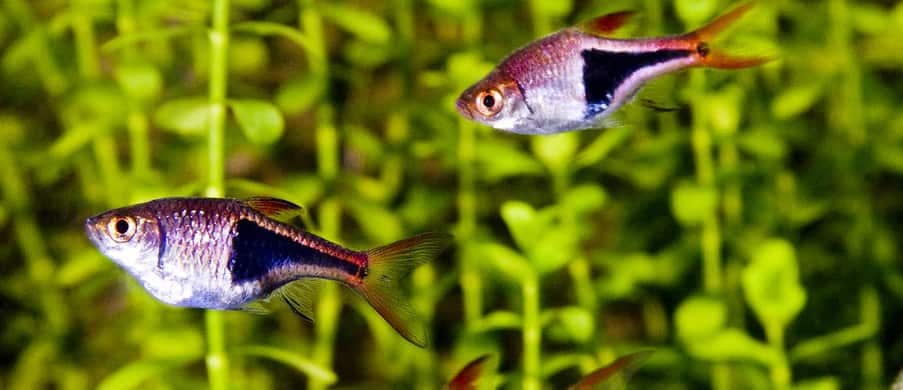
Description:
Harlequin rasboras vivid freshwater fish with brownish-gold bodies. They have a unique black triangle pattern. Often giving a flash of color and dynamic movement, they are calm, resilient, and great additions to community aquariums. These fish create an amazing visual show since they are a schooling fish.
Size:
1 to 1.5 inches (25 mm to 38 mm)
What is the difference between male and females:
Although it might be difficult to tell male from female harlequin rasboras, here are some guidelines:
Females seem to have rounder, larger bodies. Usually, males are leaner and more streamlined.
Males sometimes show more vivid and strong hues, especially during breeding. Their black triangle patch comes out as more defined.
Males may exhibit more aggressive and competitive tendencies, particularly during breeding displays when they flare their fins, chase other males and pursue females.
Lifespan:
Harlequin rasboras may live 5 to 8 years.
Behavior:
Harlequin Rasboras are friendly and social fish that love to school together. They fit in nicely in a community aquarium.

Colors and types:
Harlequin rasboras are golden-tan with black coloring along the back half of the fish.
Breeding
Breeding Rasboras is like preparing for a quirky underwater dance-off! While it’s a bit of a challenge, it’s totally doable. Start with soft water in your breeding tank and get two lovely ladies and one lucky fella. Fill the tank with plenty of plants – it’s like setting the stage for a romantic movie.
When they’re in the mood for some fishy romance, the female Rasbora will gracefully signal the male by cozying up to a chosen leaf. Then, she’ll elegantly lay her eggs on the underside of the leaf, and our male hero will swoop in to fertilize them. Be sure to remove the parents after the deed is done, or they’ll turn into egg-munching monsters. The eggs will hatch in 18 to 24 hours, and voila! You’ve got baby Rasboras!
Water conditions:
They like standard tropical water conditions. In the wild, Rasboras inhabit very soft water, so they prefer softer water that is not more than medium hardness.
Cost:
$3.50 in the big box pet stores. About $10 each on eBay. I did find some strangely low prices on eBay. You’ll need to search for yourself.
Fish Food Warnings
Warning #1: Be aware that bloodworms are dangerous to fish. I’ve experienced fish dying as a result of feeding them bloodworms. Don’t feed bloodworms, dried or especially frozen, to fish.
Warning #2: When you reach the end of a container of fish food and there is only debris and dust, throw that away. The fish can’t eat the dust, and it can get in their gills.
Aquascape:
Aquarists choice.
Original habitat:
Tropical Southeast Asia and Tropical China
Fascinating fact:
Harlequin Rasboras scientific name, Trigonostigma heteromorpha, refers to their unique triangular black patch. “Trigonostigma” means “triangle mark,” and “heteromorpha” means “different shape.”
Buying:
Nearly always available in pet stores. Always available online.
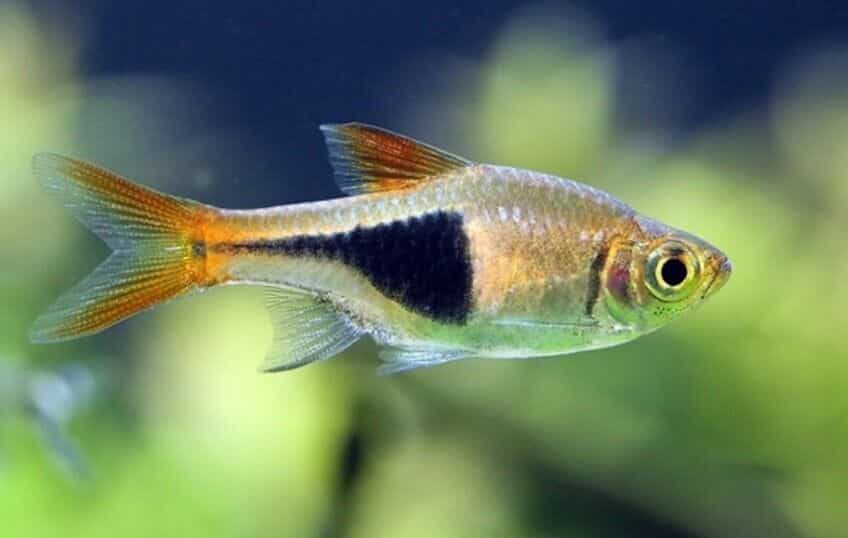
Pictus Catfish
Ease of care: very easy
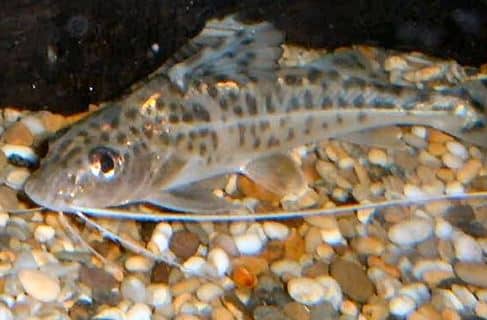
Pictus catfish (Pimelodus Pictus) are attractive and non-teritorial. They are active and exciting to watch as they swim at the bottom of the aquarium searching for food.
They are native to the Orinoco and Amazon river basins in South America.
Water conditions: They prefer soft water that is around 75° F to 81° F.
Growth: Pictus Cats grow to be about 4 to 5 inches in length.
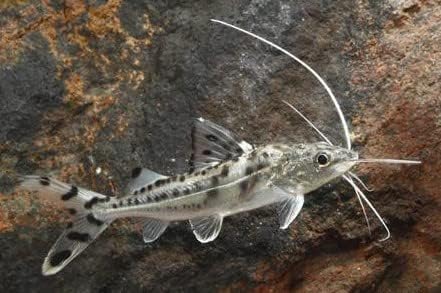
Aquarium size: The tank size recommended for the pictus catfish is 30, lightly stocked gallons.
Temperament: Temperament of Pictus Catfish is peaceful although they will try to eat fish smaller than themselves.
Lifespan: Pictus Catfish live about 6 years.
Feeding: Pictus Catfish are omnivores. They can be fed algae tablets, small fish, insects, daphnia and brine shrimp.
Breeding: Pictus fish are a typical egg-laying fish, but difficult to breed in captivity. It is unlikely that they will breed in a home aquarium.
Colors: Pictus Catfish is a silver color with black spots. They have white barbels (whiskers) and transparent fins.
Availability: Pictus catfish are readily in pet stores and online.

Dwarf Gourami
Ease care: very easy
“Honey” Dwarf Gourami
Image provided by Aquatic Heavens, an Amazon Store.
Tap picture to price or buy a Honey Gourami.
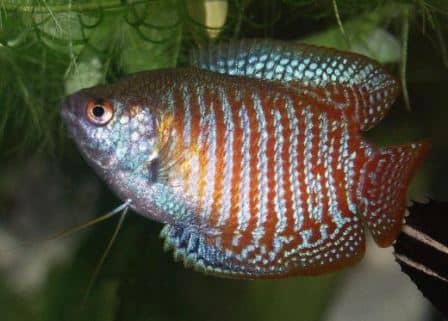
Dwarf gourami – blue with red stripes
Dwarf gourami (Trichogaster Lalius) is a colorful and peaceful fish. They are easy to care for (I.E. hard to kill) and stay relatively small (3.5 inches) so they make a good addition to a freshwater, community tank.
Dwarf Gouramis are native to South Asia, mainly Bangladesh, India, and Pakistan.
The Dwarf Gourami is a labyrinth fish. This means that they have a special organ that allows them to breathe air.
Dwarf Gouramis inhabit slow running waters in rivers, lakes, and streams.
You really don’t want to get just one Dwarf Gourami so allow at least 10 gallons of sparsely stocked tank space for each Dwarf Gourami you buy.
They like tropical water temperatures but can tolerate slightly higher than average temperatures. This heat tolerance could make them a good addition for a discus tank. They are fairly tolerant of different pH levels.
Lifespan: Dwarf Gouramis will live 4 to 5 years.
Feeding: Dwarf Gouramis are omnivores. In the wild they feed on small invertebrates, algae, and other plant matter. You can offer them high-quality live and frozen foods, flakes, tablets, and canned or cooked vegetables.
Breeding: Dwarf Gouramis are best bred in a separate breeding tank with the parents being removed after spawning. This is because they will eat the eggs given a chance.
Colors and types: They come in honey color with red vertical, dotted stripes and blue fins. They are also available in red, blue/red, white and blue with irregular dot patterns.
Tiger Barbs
Ease of care: easy

Above: Tiger Barbs in my 75 gallon aquarium
Description:
I have about 13 Tiger Barbs in my 75 gallon aquarium (See picture above). I think they are a great fish to keep.
Tiger Barbs (Puntigrus tetrazona) are a colorful very active fish. They are easy to care for (I.E. hard to kill) and stay relatively small (2.5 inches) so they make an OK addition to a freshwater, community tank.
Please note: They are a bit aggressive with each other. They will nip at other fishes fins. They love Ramshorn snails so if you have a lot those snails you won’t for long.
Size:
My Tiger Barbs about 2 years old and are now 2+ inches in length.
Male / females:
It’s quite easy to tell the males from the female. The females have a wider body and are a bit stockier.
Lifespan:
Sources say 5 to 7 years. I can’t verify that. My Tiger Barbs are about 2 years old. They are being kept in extremely good conditions. I will let you know in 3 to 5 years (about 2028).
Behavior:
I’ve read that they nip other fish. I’ve never seen that. Mainly my Tiger Barbs beg for food and chase each other around.
They seem to like Ramshorn snails, if they happen to notice one it will become a snack.
Colors:
Mostly you will find Tiger Barbs in the common colors of silver body, black strips running from top to bottom, and orange red fins and snout. Snouts on males will be very red if spawning or fighting for dominance.
Tiger Barbs come in a dusky green body with similar colors. I don’t find these barb attractive at all.
You can also find albino Tiger Barbs. They have a yellow body with white stripes. Snout and fin colors seem to be the same as regular Tiger Barb.
Breeding
Tiger Barbs are egg layers. Give the mating pair their own tank. Cover the tank bottom with something that the eggs can fall into so the parents can’t eat them. Feed the parents heavily. After they have bred, remove them from the tank. After the eggs hatch and the fry are free swimming, begin feeding them appropriate size food. When they are big enough you can put them with the rest of your Tiger Barbs.
Water conditions:
They seem to be adaptable to whatever is coming out of your tap. I’ve kept them in very hard water and very soft water. They didn’t seem to care.
They are tropical fish so keep the water temperature around 78 degrees F.
Cost:
Average cost in a fish store or online is $7 to $10.
Feeding:
Tiger Barbs will eat just about any fish food you throw in the tank. They are not picky at all.
Aquascape:
Owners Choice.
Original habitat:
Tiger Barbs are native to Southeast Asia (Cambodia and Indonesia).
Fascinating fact:
I don’t know if it is a fascinating fact, but it is super, super important to buy as many as you can afford and can fit in your aquarium. If you only buy 2 or 3 they will hide just about all the time.
Buying Tiger Barbs:
Tiger Barbs are readily available online or in just about any pet store.
Discus
Discus Care
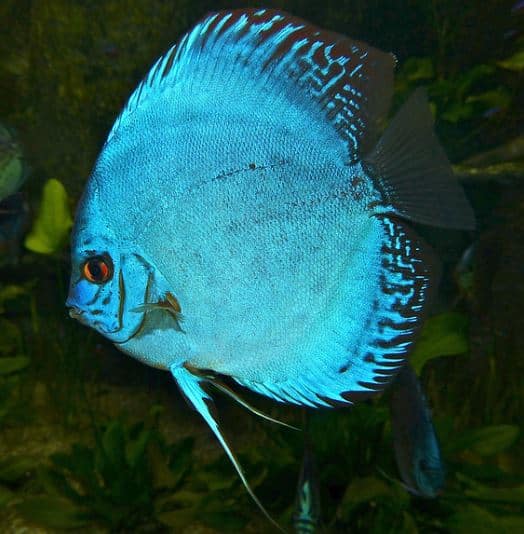
Oscar Fish
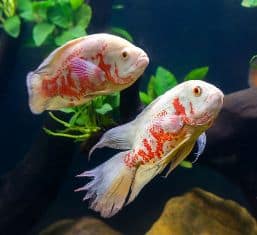
Corydora
Panda Corydora Care
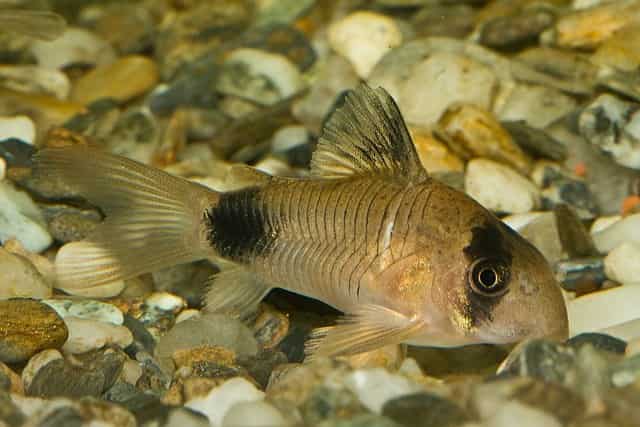
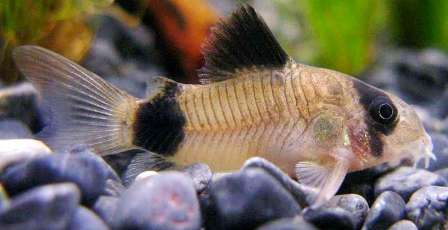
Categories: Small Fish, Peaceful Fish
How to Feed Your Fish Like a Pro: 9 Foods They’ll Love
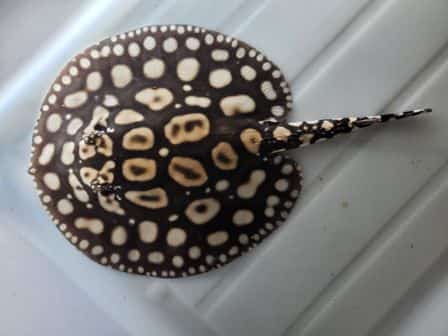

Freshwater shrimp
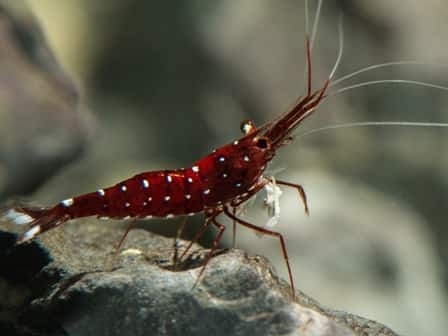
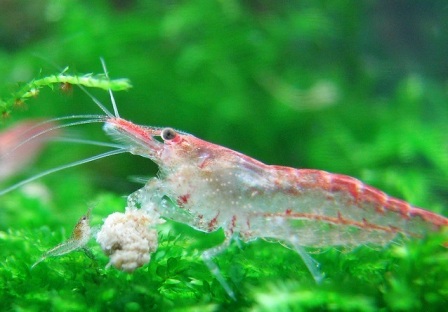
Zippy Zebra Danios:
Adding Sparkle to Your Tank!

